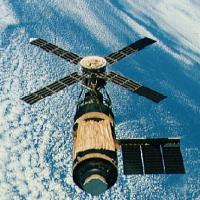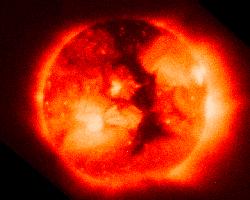 |
|
+ Home | ||

|
||||
| + Solar Cycle Prediction | + Magnetograph | + The Sun in Time | + The Hinode Mission | + The STEREO Mission |
The Skylab Missions
|
MSFC Solar Physics Branch members were involved with the soft x-ray telescope, S-056. This grazing incidence telescope produced images of the Sun in x-rays with wavelengths from 6 to 49 Å. Images (84 kb GIF image) taken through 6 different filters were recorded on film which was then returned to Earth with the astronauts for processing. A movie (601 kb mpeg movie) of these images shows some of the discoveries made from Skylab including coronal holes and x-ray bright points. Coronal holes are seen as dark regions in which the hot coronal material is very thin. X-ray bright points are small, compact, short-lived brightenings that are most easily seen in the coronal holes themselves. Coronal holes were observed to rotate fairly rigidly and maintain their shape through several 27-day solar rotations in spite of the variations in rotation rate of the solar surface. | ||
|
When Skylab was launched it lost a solar panel and part of its external shielding. Skylab astronauts had to rig a "golden umbrella" to keep their habitat comfortable. Skylab re-entered the Earth's atmosphere in 1979 over Australia. This re-entry was a year or two earlier than expected.
| |||

